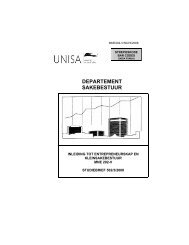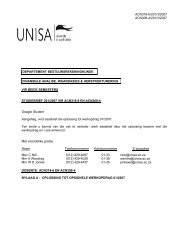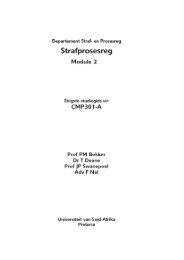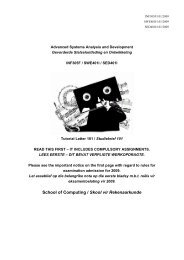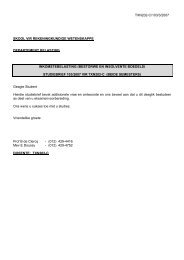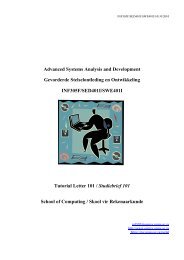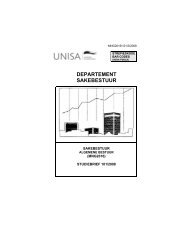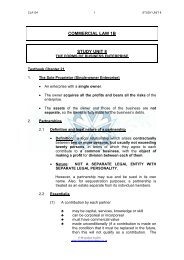key to the study guide - Name
key to the study guide - Name
key to the study guide - Name
Create successful ePaper yourself
Turn your PDF publications into a flip-book with our unique Google optimized e-Paper software.
Section 17(1) of<br />
Act Ð instituting<br />
legal proceedings<br />
Section 17(4) of Act<br />
Ð application for<br />
sequestration<br />
against both<br />
spouses/application<br />
for surrender of<br />
joint estate by both<br />
spouses<br />
Section 17(5) of<br />
Act Ð liability of<br />
spouses for debts of<br />
joint estate<br />
114<br />
Nel case: <strong>the</strong> action can be instituted<br />
only after dissolution of <strong>the</strong> marriage.<br />
Reyneke case: it seems illogical <strong>to</strong> grant<br />
this right <strong>to</strong> <strong>the</strong> innocent spouse,<br />
but <strong>to</strong> delay <strong>the</strong> ability <strong>to</strong> enforce it<br />
until dissolution of <strong>the</strong> joint estate<br />
by which time <strong>the</strong> right may be<br />
useless.<br />
Cronje and Hea<strong>to</strong>n: in favour of <strong>the</strong> decision in<br />
Reyneke<br />
(8) An application for <strong>the</strong> declaration of one spouse as a prodigal. There<br />
are two requirements for this application. They are:<br />
(a) The person must squander his or her assets in an irresponsible and<br />
reckless manner.<br />
(b) The squandering must be due <strong>to</strong> a defect in <strong>the</strong> person's power of<br />
judgment or character.<br />
These two requirements are not set out in <strong>the</strong> textbook and you do not<br />
have <strong>to</strong> know <strong>the</strong>m for purposes of <strong>the</strong> Family Law module.<br />
6 CAPACITY TO LITIGATE<br />
Capacity <strong>to</strong> litigate is <strong>the</strong> capacity <strong>to</strong> act as a party in a court case<br />
You will note in your textbook on pages 85±87 that section 17 of <strong>the</strong><br />
Matrimonial Property Act regulates <strong>the</strong> capacity <strong>to</strong> litigate of spouses<br />
married in community of property. You must ensure that you know, first,<br />
what <strong>the</strong> terms of section 17(1) are and, secondly, what <strong>the</strong> consequences<br />
of non-compliance with <strong>the</strong> provisions of this subsection are.<br />
Regarding <strong>the</strong> provisions of section 17(4), you need only know that an<br />
application for <strong>the</strong> sequestration of <strong>the</strong> joint estate must be brought<br />
against both spouses, and that an application for <strong>the</strong> surrender of <strong>the</strong> joint<br />
estate must be made by both spouses. Although an application for<br />
sequestration has <strong>to</strong> be brought against both spouses, <strong>the</strong> application will<br />
not be dismissed if it is brought against one spouse only, if <strong>the</strong> applicant<br />
satisfies <strong>the</strong> court that, despite reasonable steps, he or she was unable <strong>to</strong><br />
establish whe<strong>the</strong>r <strong>the</strong> deb<strong>to</strong>r is married in community of property or <strong>the</strong><br />
name and address of <strong>the</strong> deb<strong>to</strong>r's spouse.<br />
Lastly, you should note <strong>the</strong> provisions of section 17(5) of <strong>the</strong> Matrimonial<br />
Property Act. You will see in your textbook on page 87 that section 17(5)<br />
stipulates which spouse should be sued when a debt is recoverable from <strong>the</strong><br />
joint estate. This section of <strong>the</strong> work is <strong>the</strong>refore linked <strong>to</strong> <strong>the</strong> previous



